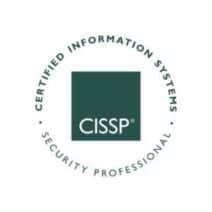Description
Students have asked for pricing options, we have delivered. Expanding Security’s CISSP is so robust we think you might want to do it with more or less instructor interactions/meetings. All class lectures are recorded for your review. We only do live fire exercises in our meetings. You can buy unlimited interactions, 25 that meet your goals or 10 if you are on a budget. Email to setup a discussion and a pre-test to find out your needs.
“10” gives you all the content online and 10 meetings to spend anyway you want.
“25” adds 25 meetings, and a 30 minutes of one-to-one.
“Unlimited” gives you a year’s worth of interactive, the pass guarantee, a set of paper mindmaps, and 60 minutes of one-to-one.
This cybersecurity certification is an elite way to demonstrate your knowledge, advance your career and become a member of a community of cybersecurity leaders. It shows you have all it takes to design, engineer, implement and run an information security program.
CISSP
- Certified Information Systems Security Professional is an independent information security certification.
- As of 1 January 2018, there are 122,289 CISSP’s worldwide.
- Governing Body: International Information System Security Certification Consortium,(ISC)²
- External exam costs: $699 in United States
- Price does/does not include exam
https://www.isc2.org/Certifications/CISSP
Security / Managerial / Certification
This is a DOD 8570 compliant course fitting for the following roles:
- IAT III, IAM III,IASAE II, CSSP Ma
This course fulfills NICE/NICCS Roles of:
- Executive Cyber Leadership – OV-EXL-001
- Cyber Policy and Strategy Planner (OV-SPP-002)
We expect every student to learn the knowledge, skills, and abilities necessary to develop and support an enterprise security program. As a side benefit of the course students will pass the exam and validate thier skills as a cybersecurity professional via certification.
- Identify and use computer networking concepts and protocols, and network security methodologies.
- Understand basic risk management processes.
- Execute secure network administration principles.
- Distinguish and differentiate cyber threats and vulnerabilities.
- Manage a team of three for two years
- Perform team member evaluations
- Write and/or review vendor contracts, statements of work, or memorandums of understanding
- A suitable certification replacement for technical or security experience would be CompTIA Security+.
- Build an information security risk management program and convey it through governance and policy.
- Applying secured design principles for communication to network security.
- Performing asset management security through classification program.
- Designing cyber security metrics programs through assessment and testing.
- Managing and maintaining identity access management in the enterprise and the cloud.
- Architecting and engineering cyber security controls that adequately mitigate threats.
- Enhancing security operations through continuity, physical controls, and personal life safety.
- Securing the software development lifecycle in the enterprise.
Domain Security and Risk Management
- Understand and apply concepts of confidentiality, integrity, and availability
- Evaluate and apply security governance principles
- Alignment of security function to business strategy, goals, mission, and objectives
- Organizational processes (e.g., acquisitions, divestitures, governance committees)
- Organizational roles and responsibilities
- Security control frameworks
- Due care/due diligence
- Determine compliance requirements
- Contractual, legal, industry standards, and regulatory requirements
- Privacy requirements
- Understand legal and regulatory issues that pertain to information security in a global context
- Cyber crimes and data breach
- Licensing and intellectual property requirements
- Import/export controls
- Trans-border data flow
- Privacy
- Understand, adhere to, and promote professional ethics
- Develop, document, and implement security policy, standards, procedures, and guidelines
- Identify, analyze, and prioritize Business Continuity requirement
- Develop and document scope and plan
- Business Impact Analysis
- Contribute to and enforce personnel security policies and procedures
- Candidate screening and hiring
- Employment agreements and policies
- Employment agreements and policies
- Onboarding and termination processes
- Vendor, consultant, and contractor agreements and controls
- Compliance policy requirements
- Privacy policy requirements
- Understand and apply risk management concepts
- Identify threats and vulnerabilities
- Risk assessment/analysis
- Risk response
- Countermeasure selection and implementation
- Applicable types of controls (e.g., preventive, detective, corrective)
- Security Control Assessment
- Monitoring and measurement
- Asset valuation
- Reporting
- Continuous improvement
- Risk frameworks
- Understand and apply threat modeling concepts and methodologies
- Threat modeling methodologies
- Threat modeling concepts
- Apply risk-based management concepts to the supply chain
- Risks associated with hardware, software, and services
- Third-party assessment and monitoring
- Minimum security requirements
- Service-level requirements
- Establish and maintain a security awareness, education, and training program
- Methods and techniques to present awareness and training
- Periodic content reviews
- Program effectiveness evaluation
- Domain Asset Security
- Identify and classify information and assets
- Determine and maintain information and asset ownership
- Protect privacy
- Data owners
- Data processors
- Data remanence
- Data remanence
- Collection limitation
- Ensure appropriate asset retention
- Determine data security controls
- Understand data states
- Scoping and tailoring
- Standards selection
- Data protection methods
- Establish information and asset handling requirements
Domain Security Architecture and Engineering
- Implement and manage engineering processes using secure design principles
- Understand the fundamental concepts of security models
- Select controls based upon systems security requirements
- Understand security capabilities of information systems
- Assess and mitigate the vulnerabilities of security architectures, designs, and solution elements
- Client-based systems
- Server-based systems
- Database systems
- Cryptographic systems
- Industrial Control Systems
- Cloud-based systems
- Distributed systems
- Assess and mitigate vulnerabilities
- Cryptographic life cycle
- Cryptographic methods
- Public Key Infrastructure
- Key management practices
- Digital signatures
- Non-repudiation
- Integrity
- Understand methods of cryptanalytic attacks
- Digital Rights Management
- Apply security principles to site and facility design
- Implement site and facility security controls
- Wiring closets intermediate distribution facilities
- Server rooms data centers
- Media storage facilities
- Evidence storage
- Restricted and work area security
- Utilities and Heating, Ventilation, and Air Conditioning
- Environmental issues
- Fire prevention, detection, and suppression
Domain Communication and Network Security
- Implement secure design principles in network architectures
- Open System Interconnection and Transmission Control Protocol/Internet Protocol (TCP/IP) models
- Internet Protocol networking
- Implications of multilayer protocols
- Converged protocols
- Software-defined networks
- Wireless networks
- Secure network components
- Operation of hardware
- Transmission media
- Network Access Control devices
- Endpoint security
- Content-distribution networks
- Implement secure communication channels according to design
- Voice
- Multimedia collaboration
- Remote access
- Data communications
- Virtualized networks
Domain Identity and Access Management
- Control physical and logical access to assets
- Information
- Systems
- Devices
- Facilities
- Manage identification and authentication of people, devices, and services
- Identity management implementation
- Single/multi-factor authentication
- Accountability
- Session management
- Registration and proofing of identity
- Federated Identity Management
- Credential management systems
- Integrate identity as a third-party service
- On-premise
- Cloud
- Federated
- Implement and manage authorization mechanisms
- Role Based Access Control
- Mandatory Access Control
- Discretionary Access Control
- Attribute Based Access Control
- Manage the identity and access provisioning lifecycle
Domain Security Assessment and Testing
- Design and validate assessment, test, and audit strategies
- Internal
- External
- Third-party
- Conduct security control testing
- Vulnerability assessment
- Penetration testing
- Log reviews
- Synthetic transactions
- Code review and testing
- Misuse case testing
- Test coverage analysis
- Interface testing
- Collect security process data
- Account management
- Management review and approval
- Key performance and risk indicators
- Backup verification data
- Training and awareness
- Disaster Recovery and Business Continuity
- Analyze test output and generate report
- Conduct or facilitate security audits
Domain Security Operations
- Understand and support investigations
- Evidence collection and handling
- Reporting and documentation
- Investigative techniques
- Digital forensics tools, tactics, and procedures
- Understand requirements for investigation types
- Administrative
- Criminal
- Civil
- Regulatory
- Industry standards
- Conduct logging and monitoring activities
- Intrusion detection and prevention
- Security Information and Event Management
- Continuous monitoring
- Egress monitoring
- Securely provisioning resources
- Asset inventory
- Asset management
- Configuration management
- Understand and apply foundational security operations concepts
- Need-to-know
- Least privileges
- Separation of duties and responsibilities
- Privileged account management
- Job rotation
- Information lifecycle
- Service Level Agreements
- Apply resource protection techniques
- Media management
- Hardware and software asset management
- Conduct incident management
- Detection
- Response
- Mitigation
- Reporting
- Recovery
- Remediation
- Lessons learned
- Operate and maintain detective and preventative measures
- Firewalls
- Intrusion detection and prevention systems
- Whitelisting/blacklisting
- Third-party provided security services
- Sandboxing
- Honeypots
- Honeynets
- Anti-malware
- Implement and support patch and vulnerability management
- Understand and participate in change management processes
- Implement recovery strategies
- Backup storage strategies
- Recovery site strategies
- Multiple processing sites
- System resilience, high availability, Quality of Service, and fault tolerance
- Implement Disaster Recovery processes
- Response
- Personnel
- Communications
- Assessment
- Restoration
- Training and awareness
- Test Disaster Recovery Plans
- Read-through/tabletop
- Walkthrough
- Simulation
- Parallel
- Full interruption
- Participate in Business Continuity planning and exercises
- Implement and manage physical security
- Perimeter security controls
- Internal security controls
- Address personnel safety and security concerns
- Travel
- Security training and awareness
- Emergency management
- Duress
Domain Software Development Security
- Understand and integrate security in the Software Development Life Cycle
- Development methodologies
- Maturity models
- Operation and maintenance
- Change management
- Integrated product team
- Identify and apply security controls in development environments
- Security of the software environments
- Configuration management as an aspect of secure coding
- Security of code repositories
- Assess the effectiveness of software security
- Auditing and logging of changes
- Risk analysis and mitigation
- Assess security impact of acquired software
- Define and apply secure coding guidelines and standards
- Security weaknesses and vulnerabilities at the source-code level
- Security of application programming interfaces
- Secure coding practices
We do not do lecture in our interactions and meetings, they are recorded for your viewing. What do we do?
There are 15 different possible exercises that can be used in the course of a one hour meeting. Some examples include: threats and controls, case studies, risk analysis practice, and systems security engineering review.
Students will read before class, take a practice test, submit case study information, and build flashcards. Each activity is graded as needed.
We use a custom textbook developed by our internal experts. Is a completely digital format.
- 1 hour per session
- 5 Sessions per week
- 10 weeks with 2 break weeks
- Orientation is held for 90 minutes before first live class.
- Class meeting times are listed on the public calendar.




